Recruits of the Province of Estremadura
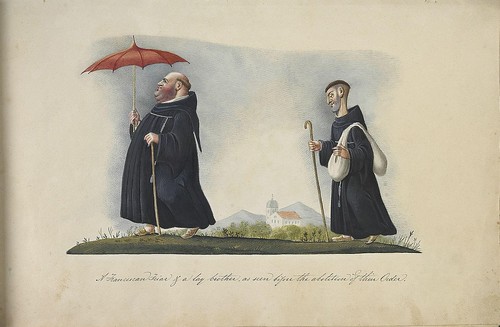
A Franciscan Friar & a lay brother, as seen before the abolition of their Order
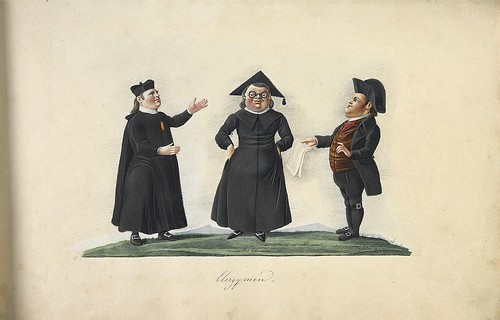
Clergymen
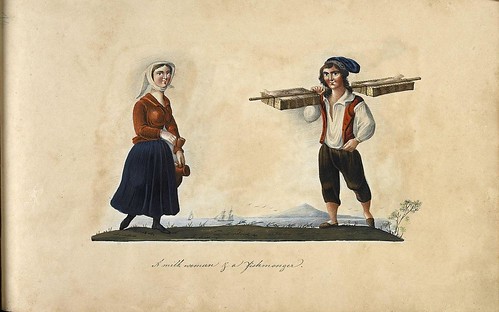
A milk woman & a fishmonger

A soldier of the Provisorial Battalions, + a National Guard
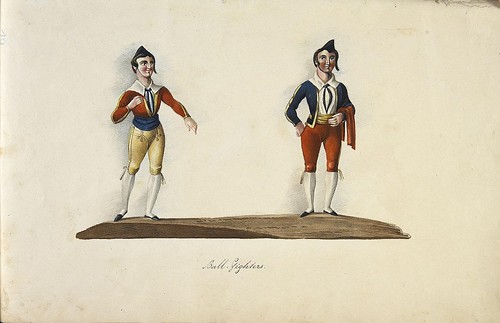
Bull Fighters
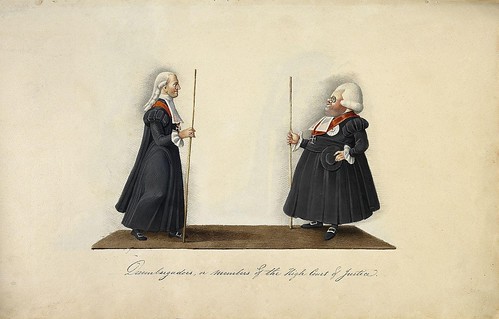
Dezembargadores, or Members of the Hight Court of Justice
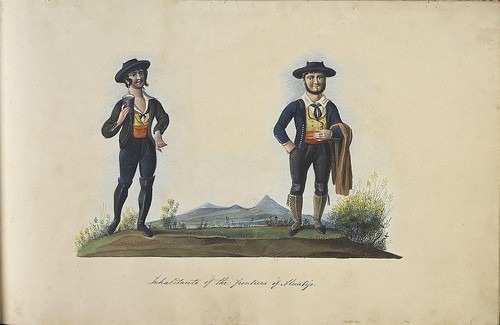
Inhabitants of the frontiers of Alentejo

Members of the Municipal Corps in grand galla dress + deep mourning

Nuns of the Order of St Bernard and St Francis

Peasants of Madeira

Peasants of Upper Beira

Western inhabitants of Madeira
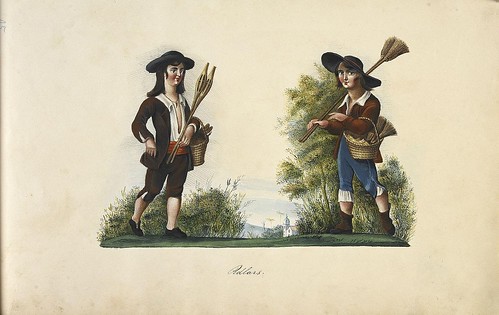
Pedlars
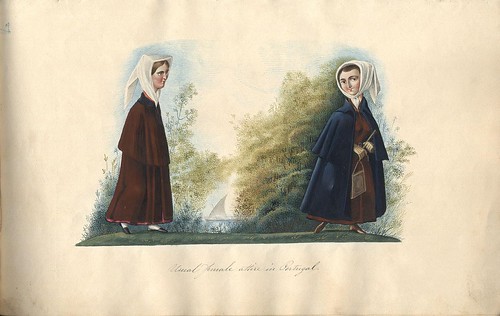
Usual female attire in Portugal
'Picturesque Review of the Costume of the Portuguese' is an album of twenty one gouache sketches from about 1836, owned and hosted by the National Library of Portugal.
The only background appears to be a circumstantial relationship with another album from the same time period, but the identity of the artist is not known.
I suspect that the album was produced by a Portuguese artist as a memento for sale or as a gift for a British tourist. The sketches are sympathetic and most I would describe as quaint portraits. Even the true caricatures are gently humorous without any hint of malevolence. The language in the title and in some of the captions is just a little skewed or unusual, more likely associated with a non-native speaker, to my mind. I may of course be completely wrong. It's a sweet little series in any event.
All of the images above have been fairly extensively - but not severely - cleaned up, including removal of the library stamps. There was quite a bit of age related background staining.
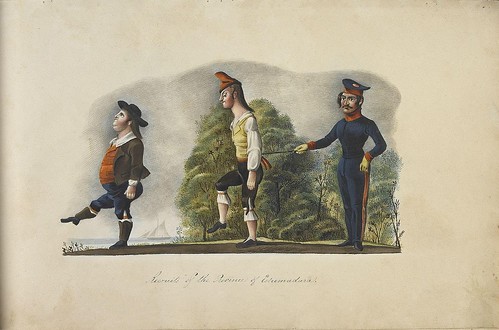



















16 comments :
Those do indeed have their own peculiar charm. Something about them brings to mind little lead or tin figures. The sort of goosestepping recruit, in his rotundity, is weirdly enchanting. (Also sort of like Edward Lear's drawings.)
So that's what Portuguese people look like!
-theorist
-fadetheory.com
Olá Peacay,
the artist was for sure British but never Portuguese !
Let me explain, lets have a look to "Exercise em Estremadura"
- it was a German, Count Lippe, as General of the British army during the war of 7 years who taught the Portuguese to march...to use soap, not to steal, introduced medical care, helped them financially.
BUT:
- he introduces the horsewhip to punish the soldiers.
- he forced the noblemen to march as well ! Servants were forbidden, aristocratic rights were abolished (1768)and only who could read and write made career....
- the noblemen look up to the sky for divine help against the Portuguese minister Pombal !
- the ordinary people with the phrygian hat of liberty on... look sad aswell, disciplin has never been en vogue em Portugal.
- can you see the way of marching ?
The noblemen has learnt his lesson...and marches like a Prussian German !
The countryman marches the way the soldiers, policemen still march today...a little bit clumsy.
Peacay, do you really think this is Portuguese humor ?
No it isn´t.
This is most British humor !!
abraço
here is my link to the number of convents in Portugal 1834 (.en)
http://briefeankonrad.blogspot.com/search?q=orden+konvent
Ralf
Ha! ok. I did say I could be wrong. But I'm not convinced that the artist was British. The writing/language makes it unlikely. If I had come across these sketches with no background to go on, I would have thought they were French actually, but it's a period style.
Incidentally, Count Lippe is the SPECTRE agent tasked with getting a plastic surgery-aided double of Francois Derval onto a nuclear-equipped NATO bomber. He also engages in an unsuccessful game of cat and mouse with Bond at Shrublands.
OT I know, but it's nice to find somebody who's as much of a James Bond (Sean Connery) nerd as me!
Dear Peacay
In the first place, I need to greet your magnificent initiative and blog. So, about the Portuguese pictures in these book, your idea about the artist intention focused in selling a good Portuguese image to the English "tourists". Why? The Portuguese Inquisition was hunting, through XVII and XVIII centuries, English citizens as "cripto-judeus" (crypto-jews).
Thanks Alcebiades for your kind words.
To repeat/elaborate my reasons for thinking the artist was more likely Portuguese than English:
1. Language --
"galla" should be "gala" I think. Perhaps a mistake? Maybe. "Bull Fighters" should be a single word. The title is also a little odd, although it could have been written by someone who was a native speaker of English. I would not write it that way myself.
2. Humour --
The sketches are sometimes meant to be satirical. But this is very gentle humour. There is no prejudice or viciousness against a nationality. It pokes fun at people and not the country (although Ralf's comment about the 'exercise' sketch may prove that I haven't fully understood the artist's intention and am missing contemporary references).
If this was by a British artist in 1836, I would expect the humour to be harsh, the stereotypes to be sharp and derogatory. I would expect it to be more offensive.
So, because it is gentle and not (very) offensive, I think it is fair to conclude that the artist is sympathetic to the subject matter. To me (when I think about the language in the captions and the title) that suggests the artist is local.
The captions and title are in english so I presume the artist (if they were indeed Portuguese) would want to sell it to a tourist; or perhaps it was commissioned as a present that was never sent.
One thing to remember: the album is IN Portugal now. If it had been made by a British artist, I would think it more likely that the album would be IN Britain now. (it's just another datapoint and not very significant in itself)
But again, I am just as easily wrong here. I'm not sure that this can be answered conclusively. Maybe we should ask someone from the British Museum Prints team. They might be more authoritative.
Count Lippe came to Portugal on request of Marquis of Pombal.
There was no portuguese military since the war of restoration.Now a little history lesson for Ralf's braggart "marches like a Prussian German" (Oh please!)Years Before Count Lippe came to Portugal.After the war of restoration which sunk Portugal already small weak economy,Portugal was struggling to maintain its weak economy.Then came King Joao the V.He was having difficulty with the Vatican to officially recognize the portuguese monarchy and Portugal's sovereignty.King Joao the V finally got his recognition but without a heavy price.
So, Yes,Ralf you have some reason when you say "disciplin has never been en vogue em Portugal"
That comment only is true since finally the portuguese where at peace before the seven year war.
Yes I do have a problem when I read egotist comments about my country.Anyone would.
Ralf,
In case you are german, as your comment suggests, I wanted to take this opportunity, as a Portuguese, to thank you for your nation's gracious transmition of marching techniques, discipline, and soap usage. It is a well known fact that before Count Lippe we took our soap orally and thanks to him we started applying it in our bodies. I will certainly think of my debt to your country when I take my monthly bath on April 14th (we also learned with Lippe to schedule our baths in a discipined way).
Peacay,
Great post. I did not know these prints. Thanks.
Caro Antonio,
the production of soap was forbidden and the monopoly of noblemen
English sailors using teir own soap but on Portuguese soil -in the harbour of Lisbon- went to prison.
Then came Pombal and on 20.12.1765 ended this monopoly.
Pombal was the heroe not Lippe.
Lippe left only Forts and Condelipas (Mushroom festival in Faro)
abraço
Ralf
Caro Ralf,
I haven't thought about Lippe in years. But because of you comment I read a bit about him today. He is an interesting fellow. I had never heard about the "Condelipas" festival but I always enjoy Portuguese adaptations of foreign names and this one is wonderful.
Reagarding you comment, you did say he taught the Portuguese how to use soap...which wasn't quite accurate - hence my reaction. Since you know quite a bit about Portugal you know we tend to react to those sorts of comments.
Abraço,
António
A portuguese ilustrator would never draw the roof of the tower of the church like a kind of a "dome". In Portugal there very few examples of that kind of roof and even less in a rural environment.
By the way...thanks for the soap...even if that is a very low price for tea and Bombay.
Caro Antonio,
as an "Observer living in Portugal" I think this picture is very funny only for Englishmen.
Gentle Humor ?
I think the satirical sense is offending simply everything about the Portuguese and very offensive.
I tried to make this level of offense clear to all readers of this wonderful blog.
The chabatada (stokes with the whip)could be misunderstood too:
it was no fun at all....
The sphrygian bobble hat was not all Portuguese.
I think the painter wanted to show: Bye, Bye liberty, forget it...
No wonder, that everyone in Portugal blamed Pombal !
The Condelipas are not mushrooms (sorry for my mistake) but mussels !
This paintings could have been property of those many sottish and english families of the Portwine business...
:)
Ralf
Ralf have you heard of the artist Rafael Bordalo Pinheiro?That is just one of many.
Many of Pinheiro illustrations has that same soft humorous veiw of Catholic clergymen and portuguese monarchic king.
But I do not see these illustrations as you do.I think you are reading into them way to much.
What you see as the phrygian "republican" cap might not actually be the cap at all but the typical hats you see for example in Ribatejo.
Campino
http://ranchobenficaribatej.home.sapo.pt/Rancho_Etnografia/Etnografia_ficheiros/imagens/trajos/campinos/campino.jpg
I agree that this album was produced for a British tourist..."para inglês ver".
I wouldn't be surprised if it was a Portuguese artist, there is a picaresque sense of humor than was common in Portuguese artists of the same period.
Post a Comment
Comments are all moderated so don't waste your time spamming: they will never show up.
If you include ANY links that aren't pertinent to the blog post or discussion they will be deleted and a rash will break out in your underwear.
Also: please play the ball and not the person.
Note: only a member of this blog may post a comment.